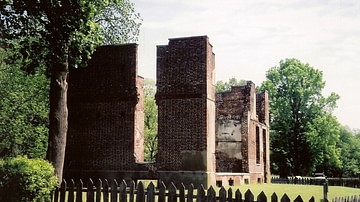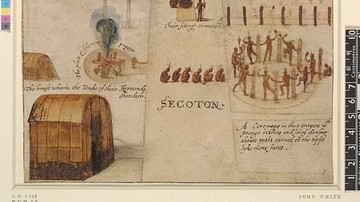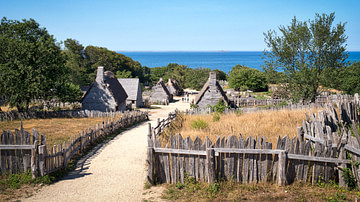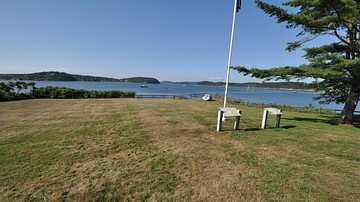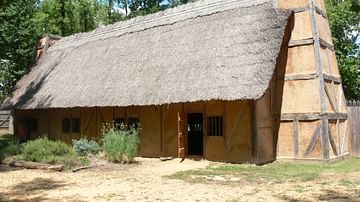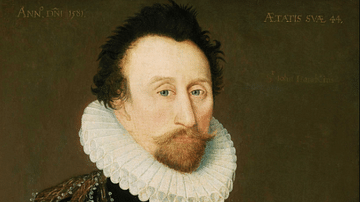Slavery in Colonial America, defined as white English settlers enslaving Africans, began in 1640 in the Jamestown Colony of Virginia but had already been embraced as policy prior to that date with the enslavement and deportation of Native Americans. Although the first Africans arrived in Virginia in 1619, chattel slavery was not institutionalized at that time.
Colonial reports from Jamestown as early as 1610 note the practice of enslaving Native Americans, and the Pequot Wars of the New England Colonies (1636-1638) ended in colonial victory and the enslavement and deportation of members of the Pequot tribe. Although institutionalized chattel slavery did not become policy in Virginia until the 1660s, therefore, the concept and practice were already well-established, having first been introduced by the Spanish and Portuguese in the Americas before the arrival of the English.
Slavery in the Americas was widely practiced by indigenous tribes who enslaved those captured in raids, wars, or who were traded from one group to another for various reasons but there was no slave trade per se. Institutionalized chattel slavery was only introduced after the arrival of Christopher Columbus (l. 1451-1506) in 1492, was developed by the Spanish and Portuguese by 1500, and was already integral to Spanish and Portuguese colonial economies by 1519.
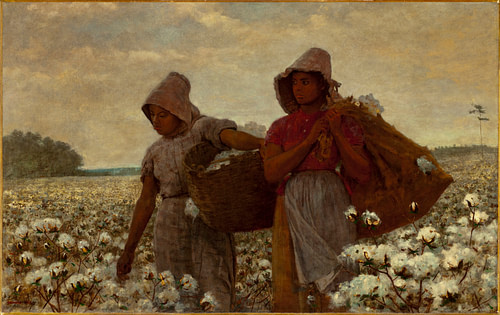
As the English colonized North America between 1607-1733, slavery became institutionalized and race-based. Native Americans who were taken as slaves were usually sold to plantation owners in the West Indies while African slaves were imported in what became known as the Triangle Trade between Europe, West Africa, and the Americas. Every one of the English colonies held slaves but the lives of the enslaved differed, often significantly, between them.
Although some colonies, such as Pennsylvania, objected to the practice, the citizens still kept slaves. The abolitionist movement gained some momentum leading up to, and away from, the American War of Independence (1775-1783), but it was not until the 19th century that concerted efforts were made to abolish the practice. The first major legislative blow to slavery was the Emancipation Proclamation issued in January of 1863 which freed slaves in the Confederate States, but slavery was not abolished in the United States until the ratification of the 13th Amendment to the Constitution in 1865 though the effects of the institution of racial slavery would continue to inform American culture up through the present day.
Columbus & the Slave Trade
Columbus did not so much "discover America" as conceive of the means of fully exploiting the people he found already living in the Caribbean, South, and Central America. On his first voyage in 1492, he kidnapped a number of natives to bring back to his patrons, King Ferdinand and Queen Isabella of Spain who had hoped he would return with massive quantities of gold. Having found no gold, Columbus offered the royal couple the natives as slaves.
On his second voyage in 1493, he kidnapped more natives, but Ferdinand and Isabella had not given their consent for this as they were uneasy about the morality and legality of enslaving people who had offered them no offense. They ordered Columbus to stop until the matter could be resolved by their theologians and legal counselors, but he ignored them and sent over 500 enslaved natives to Spain from the West Indies in 1495.
Between 1493-1496, he established the encomienda system in the lands he had claimed for Spain in which Spanish settlers were given large tracts of land worked by natives in exchange for food, shelter, and protection from the Spaniards. Ferdinand and Isabella outlawed slavery in Spain and ordered those who had been brought freed but legalized slavery and the encomienda system in their New World colonies. Once slavery was established there, the slave trade – which Columbus had already initiated – developed quickly with Spanish, Dutch, Portuguese, and French ships transporting enslaved natives to various points and Spanish colonists enslaving those who remained.
The enslavement of the indigenous peoples of the West Indies, South, and Central America continued throughout the 16th century while, to the north, the French and Dutch attempted to build alliances with the natives at the same time they profited from the slave trade in the south by shipping slaves between points of trade. The English were the last to introduce slavery to the Americas in the Colony of Virginia, first enslaving Native Americans as early as 1610 and Africans between 1640 and 1660.
Jamestown & Virginia Slave Laws
By the time the English began their colonization efforts in North America in 1585, the slave trade was regarded simply as another import-export business and the early colonists of Jamestown saw the natives of the Powhatan Confederacy as another resource to exploit. Captain John Smith (l. 1580-1631) writes of colonists regularly stealing from the natives and a report from another colonist c. 1610 claims that natives were already being taken as slaves by that time.
In 1619, a Dutch ship carrying 20 or 21 enslaved Africans arrived at Jamestown seeking supplies and provisions. Governor Yeardley (l. 1587-1627) traded these for the Africans, but they seem to have regarded as indentured servants, not slaves. The Dutch ship was not bound for Jamestown with its cargo but was forced to put into port due to shortages aboard. Slavery might have developed in the English colonies anyway, and probably would have, but this event signals the arrival of the first unwilling Africans as servants to English landowners.
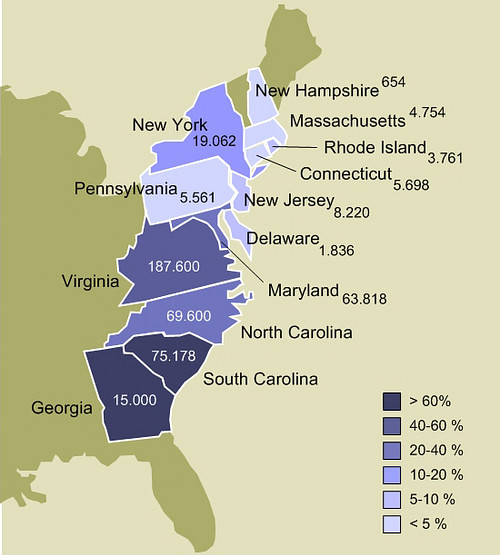
The claim that these first Africans were indentured servants, not slaves, is supported by evidence that the English colonists themselves regarded them as such. Although the Africans were purchased from the Dutch ship for the necessary supplies, they were not then enslaved by Yeardley but worked for between 4-7 years and then given their own land to farm in accordance with the policy of indentured servitude. One of these, later known as Anthony Johnson, is listed in the census prior to 1640 as a freeman and had purchased a slave of his own named John Casar.
This policy changed in 1640 when a black indentured servant named John Punch objected to the treatment he received from his master and left service in the company of two white servants. When the three were caught and returned to their master, the two whites had their terms of servitude extended by four years while Punch was condemned to lifelong servitude. Many scholars cite the Punch event as the beginning of institutionalized slavery in the English colonies. Virginia Colony passed laws restricting the rights of Africans after 1640 and, especially, during the 1660s when slavery became fully institutionalized.
New England & Middle Colonies
While Jamestown and the Virginia colonies were developing to the south, the New England Colonies were established. Plymouth Colony was founded in 1620 and Massachusetts Bay Colony in 1630 with other New England Colonies then springing up from the latter. The first record of Native American enslavement appears after the Pequot War when many of the defeated natives were sold as slaves to plantations in the West Indies. Massachusetts Bay Colony passed the first laws regarding slavery in 1641, defining justified enslavement as applying to those who were taken captive in war, convicted of a crime and enslaved as punishment, or as foreigners to the community, already enslaved by others, who were sold to colonists in New England.
Although the New England Colonies and Middle Colonies are not usually associated with slavery, they all kept slaves to greater or lesser degrees. By 1703, New York City’s slave population made up 42% of the whole and a slave market operated on the East River on Wall Street. New York also passed one of the first laws setting the death penalty for slaves who rose against or murdered their masters. Pennsylvania, the only English colony to condemn slavery, still practiced it. A petition against slavery, drafted by Quakers in 1688 and submitted to the colonial government, was filed and then forgotten until the mid-19th century.
Massachusetts Bay took the lead in profiting from the slave trade initially by shipping salted fish to plantations in the West Indies to feed their slaves and then by importing Africans as slaves from elsewhere to be sold in New England slave markets. This practice was considered legal as these people had already been enslaved by others and were only being purchased by New Englanders; it ignored, however, the fact that the market the colonies created encouraged those others to enslave and transport more and more Africans via the route known as the Triangle Trade.
The Triangle Trade & Middle Passage
The Triangle Trade was a cyclical exchange of goods and human beings between Europe, West Africa, and the Americas and enabled the Transatlantic Slave Trade. Colonists exported raw goods to Britain where they were processed into finished goods and traded with West Africa, which then sent slaves to the English colonies. Those who were taken as slaves in Africa were forced to endure the Middle Passage – the trip from Africa to North America – loaded below decks as cargo and packed as tightly as possible for maximum profit, especially since over half were expected to die before reaching their destination. Scholar Oscar Reiss elaborates:
If 18 million left Africa during the "trading period" then perhaps 6 million died. Lord Palmerston, who opposed the slave trade, believed that of every three blacks taken from the interior, one reached America. According to the tables kept by the Board of Trade between 1680 and 1688, the Africa Company shipped out 60, 783 "pieces of merchandise" and delivered 46,394 – a loss of 23 percent. In business terms, this was a loss of principal. These slaves were paid for in Africa and failure to deliver them for sale at their destination was a serious loss. (34)
To make up for that loss, the captains packed as many people as possible into the holds of their ships. Reiss continues:
They were forced to lie "spoon fashion" on their sides to conserve space. A fully grown male received eighteen inches’ width by six feet of length; women received five feet ten inches of length by sixteen inches; boys five feet by fourteen inches; and girls four feet, six inches by twelve inches. Lord Palmerston commented that they had less room than a corpse in a coffin. Crowding was so intense that the British Parliament passed a law restricting the numbers of slaves to no more than five slaves per three three-ton capacity in a ship of 200 tons. Like so much unpopular legislation, this was not obeyed by the ships’ captains. (34)
The slaves were all confined below deck in semi- or complete darkness with men, women, and boys separated and only the men manacled. In good weather, the slaves were brought up on deck – chained to prevent anyone throwing themselves overboard – and were left there sometimes all day with little water and, just like in the hold, only small buckets to relieve themselves in, which were too small and too few for the purpose they were supposed to serve.
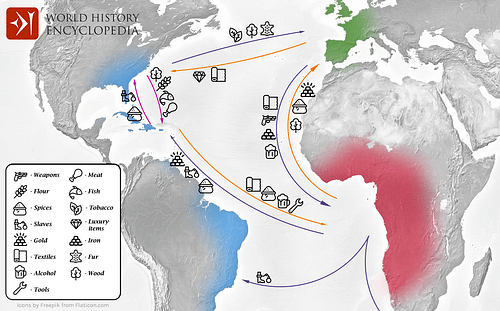
The Middle Passage was so-called because it was the second (or “middle”) of a three-part trade route that began and ended in Europe. The first passage was from Europe to Africa carrying textiles, metals, alcohol, weaponry, and other valuables which were traded for slaves who then made the middle passage to the Americas where they were traded for other valuables and commodities which were sent on the third passage back to Europe. The Triangle Trade was in full operation between the early 16th through the mid-19th century, and the majority of the slaves brought to North America went to the Southern Colonies.
Southern States Slave Laws
New England Colonies and Middle Colonies held slaves but not as many as the Southern Colonies and the work required of the enslaved was more labor-intensive in the south than in the north. Large southern tobacco, rice, and cotton plantations came to rely heavily on slave labor, while smaller farms in the north, typically worked by a farmer and his family, did not require slave labor, at least not to so great a degree. While slaves in the New England and Middle Colonies primarily worked the ports, loading and unloading ships, those in the south largely worked the fields of the plantations.
Slavery in the Southern Colonies followed the model established by the English colony of Barbados. Scholar Alan Taylor notes:
Because English law provided no precedents for managing a system of racial slavery, the Barbadians had to develop their own slave code, which they systematized in 1661. The Barbadian code became the model for those adopted elsewhere in the English colonies, particularly Jamaica (1664) and Carolina (1696), which both originated as offshoots from Barbados. (213)
The code mandated:
- No slave could leave their plantation without written permission by his or her owner.
- Slaves could not play musical instruments, beat drums, sound horns, or make loud noises that could signal rebellion.
- Whites were encouraged to ask any black person for his or her pass on the street and to search them, without cause, for weapons or contraband.
- Blacks were encouraged to inform on fellow blacks, prevent escapes, and turn over fugitives; they were rewarded with new clothes, better treatment, and given "a badge of a red cross on his right arm whereby he may be known and cherished by all good people" (Taylor, 213).
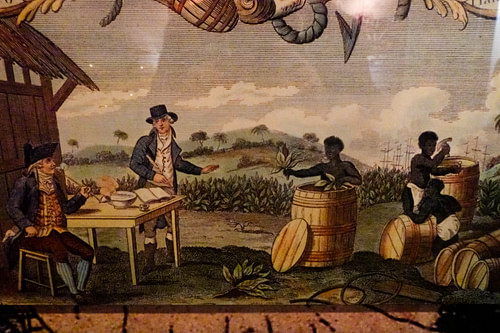
The planters unwittingly paid psychological, social, and demographic costs for adopting the West Indian slave system. And they freely shared those costs with poor whites who owned no slaves…As in the West Indies, the planters suffered from a haunting fear that their African majority would rise up in deadly, burning rebellion. In a desperate search for security, the Carolina planters adopted the West Indian system of strict surveillance and harsh punishment to keep the slaves intimidated and working. The new system criminalized formerly tolerated behavior, revoking the degree of trust and autonomy previously allowed most slaves in the frontier era. (239)
Slaves who were accused of fomenting rebellion were hanged or burned at the stake, often on little to no evidence of their guilt. The fear was fueled not only by the knowledge that the white population had enslaved and dehumanized the black populations of the region but by the memory of two early rebellions by the servant class in Virginia. The Gloucester County Conspiracy of 1663 ended before it began when it was betrayed by another servant but Bacon's Rebellion of 1676 united black and white indentured servants and slaves, resulting in the burning of Jamestown.
In spite of the repressive measures of the Southern Colonies toward the black population, revolts did break out. The Stono Rebellion of 1739 in South Carolina is the largest slave revolt launched in the Thirteen Colonies. Led by a slave named Jemmy, around 20 slaves gathered at the Stono River on Sunday, 9 September 1739, raided a warehouse for weapons, and then marched toward the safety of Spanish St. Augustine, Florida where they would be free. The slaves attacked and killed white masters, and their group swelled to at least 100 before the militia counterattacked. 25 white colonists were killed in the uprising and at least 30 blacks in the week-long battles with the militia; afterwards, more slaves were hanged, and executions went on, with little recourse to any legal proceedings, through the following year.
Conclusion
When the American War of Independence broke out in 1775, many slaves hoped they would be granted freedom since words like 'liberty' and 'justice' and phrases regarding an 'end to oppression' were frequently heard from white masters. Some black slaves served in the Continental Army in place of their masters in return for their freedom but, when the war ended, slavery was still in place in the colonies.
The New England and Middle colonies abolished slavery by 1850, in part due to pressure from the growing abolitionist movement, but also, they could afford to do so because, as noted, the northern economy was not as dependent on slave labor as that of the south and became even less so through industrialization. The Southern Colonies continued the "peculiar institution", as they called it, until forced to abandon it after the American Civil War ended in their defeat in 1865.
The Thirteenth Amendment abolished slavery in the United States and freed the slaves but the systemic racism the institution had engendered did not simply vanish away. African Americans in the United States have experienced a very different America than the one lauded in song as the "land of the free and the home of the brave" and continue to do so in the present when the specter of racialized slavery manifests itself in unequal medical care, opportunities, and justice before the law for the descendants of those brought as slaves to the colonies by people claiming to have founded a land based on the concept of freedom for all.
